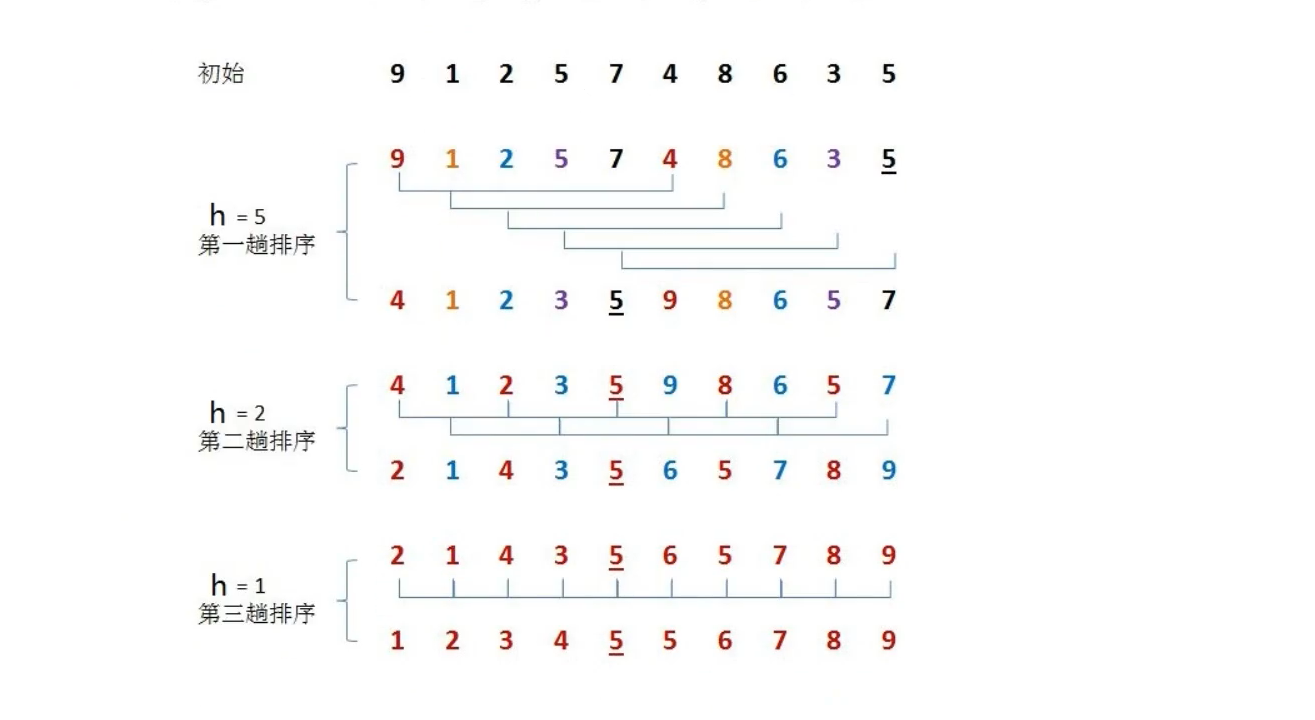希尔排序是插入排序的一种,又称“缩小增量排序”,是插入排序算法的一种更高效的改进版本。
3.4.1、需求
- 排序前:{9, 1, 2, 5, 7, 4, 8, 6, 3, 5}
- 排序后:{1, 2, 3, 4, 5, 5, 6, 7, 8, 9}
3.4.2、排序原理
- 选定一个增长量h,按照增长量h作为数组分组的依据,对数据进行分组
- 对分好组的每一组数据完成插入排序
- 减少增长量,最小减为1,重复第二步操作
增长量h的选取:
int h = 1;//默认为1
while(h<数组的长度/2){
h = 2 * h + 1;
}
#缩小增量,为h/2

3.4.3、API设计
| 类名 | Shell |
|---|---|
| 构造方法 | Shell:创建Shell对象 |
| 成员方法 | public static void sort(Comparable[] a):对数组内的元素进行排序 private static boolean grater(Comparable v,Comparable w):判断v是否大于w private static void exch(Comparable[] a,int i,int j):交换a数组中,索引i和索引j处的值 |
3.4.4、代码实现
算法类:
package cn.test.algorithm.sort;
public class Shell {
/**
* 对数组元素进行排序
*
* @param a
*/
public static void sort(Comparable[] a) {
//根据数组的长度确定增长量h的初始值
int h = 1;
while (h < a.length / 2) {
h = 2 * h + 1;
}
//进行排序
while (h >= 1) {
for (int i = h; i < a.length; i++) {
for (int j = i; j >= h; j -= h) {
if (greater(a[j - h], a[j])) {
exch(a, j - h, j);
} else {
break;
}
}
}
//减小h的
h = h / 2;
}
}
/**
* 比较v元素是否大于w元素
*
* @return
*/
private static boolean greater(Comparable v, Comparable w) {
return v.compareTo(w) > 0;
}
/**
* 交换i和j处的元素值
*
* @param a
* @param i
* @param j
*/
private static void exch(Comparable[] a, int i, int j) {
Comparable temp;
temp = a[i];
a[i] = a[j];
a[j] = temp;
}
}
测试类:
package cn.test.algorithm.test;
import cn.test.algorithm.sort.Shell;
import java.util.Arrays;
public class TestShell {
public static void main(String[] args) {
Integer[] a = {9, 1, 2, 5, 7, 4, 8, 6, 3, 5};
Shell.sort(a);
System.out.println(Arrays.toString(a));
}
}
测试结果:
[1, 2, 3, 4, 5, 5, 6, 7, 8, 9]
3.4.5、时间复杂度分析
由于希尔排序的时间复杂度事前预估法比较难,所以我们采用事后预估法,这里我们通过希尔排序和插入排序进行对比,看看希尔排序的执行时间。
package cn.test.algorithm.test;
import cn.test.algorithm.sort.Insertion;
import cn.test.algorithm.sort.Shell;
public class SortCompare {
public static void main(String[] args) {
//生成10w个证书,数据必须是倒序的,这样才是排序的最坏情况
int num = 100000;
//这里分开写两个数组
Integer[] shellArray = new Integer[num];//希尔排序数组
Integer[] insertionArray = new Integer[num];//插入排序数组
for (int i = num; i > 0; i--) {
shellArray[num - i] = i;
insertionArray[num - i] = i;
}
shellTest(shellArray);
insertionTest(insertionArray);
}
//希尔排序测试
public static void shellTest(Integer[] a) {
long startTime = System.currentTimeMillis();
Shell.sort(a);
long endTime = System.currentTimeMillis();
System.out.println("希尔排序时间:" + (endTime - startTime) + "毫秒");
}
//插入排序测试
public static void insertionTest(Integer[] a) {
long startTime = System.currentTimeMillis();
Insertion.sort(a);
long endTime = System.currentTimeMillis();
System.out.println("插入排序时间:" + (endTime - startTime) + "毫秒");
}
}
运行结果:
希尔排序时间:24毫秒
插入排序时间:20380毫秒
从结果可以看出,希尔排序的效率是非常高的。